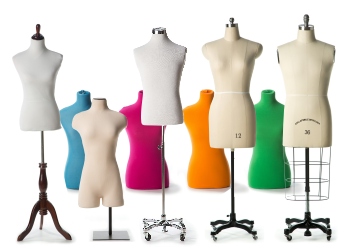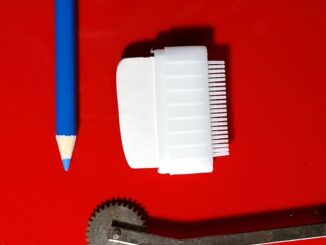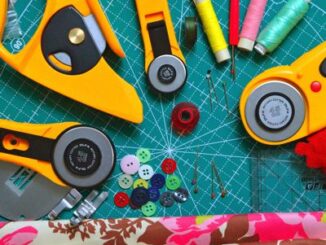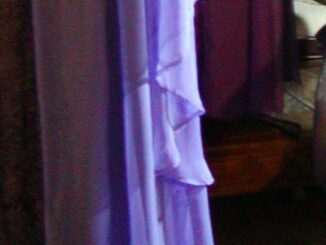 Love sewing, but hate having to try to fit things on yourself? Stop sticking yourself with pins – it’s time to take your craft to the next level. Wouldn’t it be easier if you had a tool that would allow you to see exactly how certain materials will drape and fall on a body? Aren’t you ready to get that perfect fit right away, saving yourself lots of time and effort? Then you need a dress form!
Love sewing, but hate having to try to fit things on yourself? Stop sticking yourself with pins – it’s time to take your craft to the next level. Wouldn’t it be easier if you had a tool that would allow you to see exactly how certain materials will drape and fall on a body? Aren’t you ready to get that perfect fit right away, saving yourself lots of time and effort? Then you need a dress form!
Dress forms make it pinning, adjusting, and experimenting with the look of your fabrics an extremely quick and easy task. But there are a wide variety of styles and makes to choose from, so use this handy guide. You’ll get the answers to all your questions and some tips to make buying a dress form simple. Let’s start with the basics.
What is a dress form and How is it used?
Dress forms are three-dimensional models that allow you to properly fit garments or accessories while you’re sewing them. The forms are created using layers of foam, which makes it easy use pins to change shapes or hold pieces into place. The forms are covered in cloth, which makes (and it also serves to keep the foam where it’s supposed to be).
Although the look of the form may not sound important, it’s an important element to consider. If you want to show off what you’ve made, you’ll want a good-looking dress form to display it in a storefront or in your product photography.
Is there a difference between a standard form and a professional form?
Standard dress forms are made for looks. They’re functional, of course, but they’re also made to look great standing alone or when displaying what you’ve made. Professional dress forms are made primarily for functionality and are prized for their versatility and durability. If you’re just a dabbler you’ll probably want a standard form so you can use it both to fit your sewing projects and to show them off once you’re done, however, if you do some serious sewing, you will probably want to spring for a coveted professional form.
Can you pin all dress forms in the same way?
Some dress forms are made to be more easily pinned than others. Dress forms with thinner layers of foam can be pinned, but the pin needs to be pushed in at an angle. Forms featuring very thick layers of foam can have pins pushed straight in and will hold. Fully-pinnable forms are excellent for sewers working with extremely heavy fabrics. Before nabbing a dress form, be sure to ask about its pinnability (how is that for a new fun word?) to make sure it something you are comfortable working with.
Are dress forms adjustable?
If you are like most people, your body weight fluctuates. You gain some you lose some, and it is just a fact of life. Dress forms however, do not do the whole midnight binge or crash diet thing, and being the inanimate objects they are, they stay the same size no matter what. Because of the problemo this presents, there are many innovative solutions available. First there is the classic adjustable dress form option . They feature dials that can adjust the measurements at important areas, like the bust and hips. While this can help with minor sizing changes, the dials can cause a serious fitting and pinning problem with the gaps and edges they create. Another option is padding. If you are lucky enough to find a form that is pretty close to your size, you can always pad it up so it looks exactly like you-tummy pooch, love handles, and all.
Another feature to consider is collapsible shoulders. This is a great for anyone looking to utilize a form if you want to make tops that are pulled on and off over the head. The collapsible shoulders work the exact same way your own shoulders do when you lift your arms over your head.
How do you purchase a dress form?
First, consider what you want to use your form for. This will help you determine exactly what kind and size you’ll need. There are several options available. For example, ask yourself: Do you want a male or female form? Should it be adult-sized or child-sized? Do you really need a professional form, or would you get more use out of the fashionable standard form?
Next, seek out a retailer who specializes in dress forms. They should be able to provide customers with a variety of products that are somewhat adjustable or customizable, and that offer several features. This way, you can ensure you’re purchasing exactly what you need.
And if you’re thinking about simply grabbing a mannequin and making do with that as your form, a word of caution: mannequins are not dress forms! They are made specifically for displays, and they’ll present you with a lot of problems if you attempt to sew and fit with them. They have hard exteriors that prevent pinning, and they aren’t designed to give you a perfect, realistic fit.
Happy Shopping!
Guest post written by:
Cara Pierce from The Shop Company



